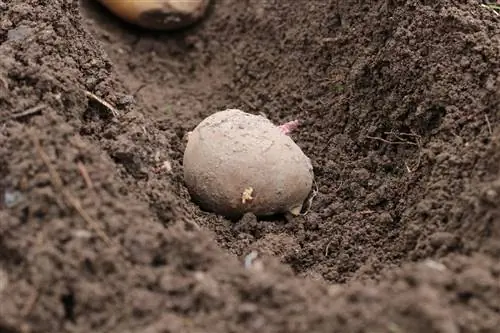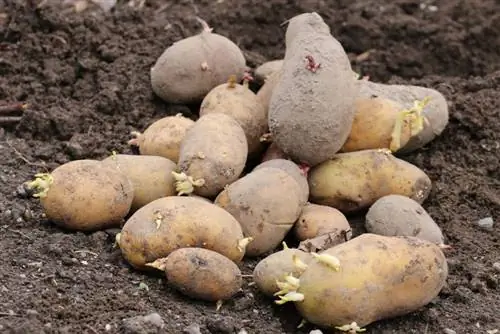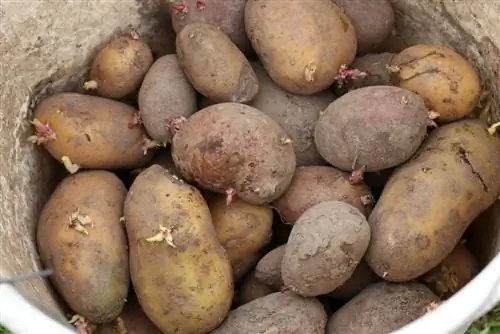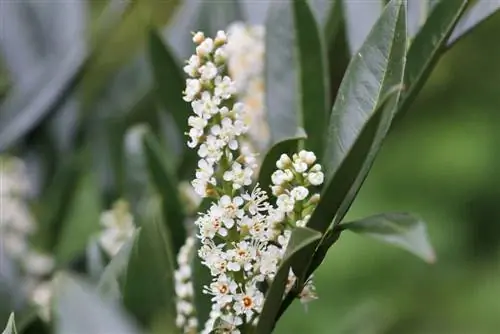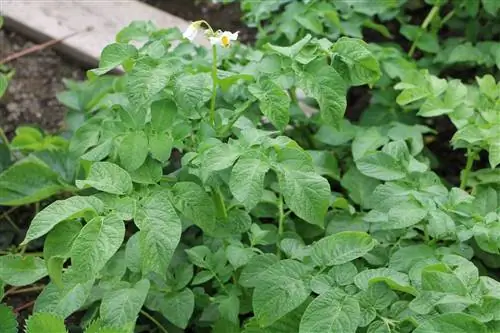- Author admin [email protected].
- Public 2023-12-17 03:39.
- Last modified 2025-01-24 12:45.
The selection of potato varieties is large. Regardless, you can harvest ten to fifteen times as many tubers from a planted potato as long as you pay attention to a few basic things when planting.
Create optimal planting conditions
Potatoes, also known as potatoes, require a humus-rich, permeable, light to medium-heavy soil. They do not tolerate waterlogging, such as that which occurs in heavy clay soils, unless it is treated with sand and compost. Sandy soils are particularly suitable.
- Pre-culture with deep-rooted vegetables can be useful
- Potato has high nutritional requirements, heavy eater
- Ideally work compost into the soil in early spring
- or spread manure on the area in the fall of the previous year
- loose the soil thoroughly before planting
- to a depth of approx. 30 cm
- Remove root residues, weeds and stones
- pay attention to crop rotation when planting potatoes
- Bulbs should be the first crop on the area
Potatoes are the optimal vegetable when it comes to cultivating the soil. However, they are incompatible with themselves and should therefore only be grown again in the same location after four years at the earliest. Planting in the immediate vicinity of tomatoes is also unfavorable, as this could promote the transmission of the dreaded late blight.
Tip:
Compost should not be worked into the soil immediately before planting. Otherwise, over-fertilization could result, which in turn affects the taste and storage stability of the tubers.
Planting time
The right time to plant depends on the region or the prevailing climatic conditions and the respective variety. Depending on whether it is early potatoes, medium early or late varieties. Basically, they should not be planted too early because the tubers are sensitive to frost. The ground should already have warmed up to around ten degrees. When temperatures no longer fall below ten degrees during the day, around March or April, early varieties can be planted. Mid-early and late follow from mid-April to mid-May.
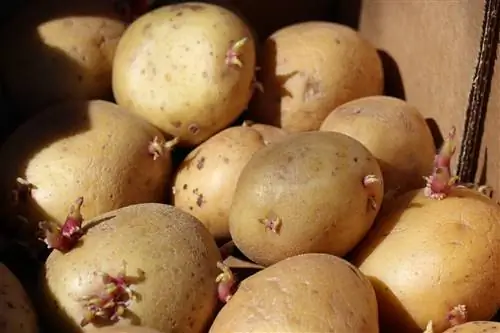
Pre-germinate potatoes
If you want to harvest the delicious tubers early, you have the option of having them pre-germinated from the end of February/beginning of March, about six weeks before planting. This means you can harvest about three weeks earlier. Pre-germinating is suitable for early potatoes as well as medium early and late varieties.
- You fill a box with commercially available potting soil
- then place medium-sized tubers of the respective variety on the soil
- cover halfway with soil
- Place the box in a bright, 15 degree warm place
- for example in the winter garden or a greenhouse
- Bulbs need a lot of light now
- within a few weeks, formation of short, strong shoots
- plant out in the bed after about six weeks
Distance and depth
So that the rows of plants run as straight as possible, it is best to use a guide line. You then make furrows in the ground along the cord with the handle of a hoe or similar device. They should be 10-20 cm deep. The distance between rows should be at least 50 cm, better 70-80 cm. If the soil has not yet been fertilized, you can add some horn meal or horn shavings to the furrows.
Then press the tubers lightly into the soil so that the existing germ points upwards. But be careful, the germs break off very easily. Early potatoes are placed 30 cm apart, medium early and late potatoes up to 60 cm apart. The furrows are then closed with a rake so that the tubers are completely covered with soil. Watering is not necessary when planting potatoes. For early potatoes, covering them with garden fleece may initially make sense, depending on the weather.
Tip:
Particularly large tubers can also be cut up and each section planted. Then each of these parts should have at least one eye. This is also a good idea if you only have a few tubers available.
After planting
As soon as the first green shoots stick their heads out of the ground and are about 20 cm high, it's time to pile up. On the one hand, this step is intended to increase the yield and, on the other hand, to prevent the daughter tubers from growing out of the soil and thus being exposed to light. This would cause them to turn green and be inedible because the green parts contain the poison solanine.
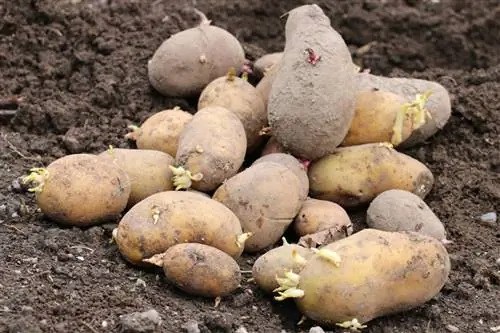
When piling up, you pull the soil towards the potato plants with a field hoe or rake so that they are about half covered with soil. New roots with additional tubers form under the embankment. This process must be repeated at intervals of approximately two to three weeks. Care must be taken not to injure the herb.
Planting in a bucket
Potatoes can also be grown on the balcony in a very space-saving manner, for example in special potato pots. Of course, you can also cultivate them in conventional large pots, in so-called plant bags or plant towers. Planting towers offer particularly good yields. The respective bucket should above all be high, dark-walled and made of plastic. Dark-walled because the soil in the pot warms up better when exposed to sunlight. Sufficient drainage holes in the bottom of the pot are essential.
- Put drainage about ten centimeters thick on the bottom of the pot
- for example made of gravel or expanded clay
- then add an approx. 15 cm thick layer of loose compost soil
- mix with sand if necessary
- place the germinated tubers on the ground at an appropriate distance
- depending on the size of the bucket, about three to four
- then a layer of soil on the tubers
- when the green shoots are about 15 cm long, pile up
Tip:
It is best to pile up specimens in the pot in the evening. Then the leaves are usually directed upwards, so they cannot be damaged so easily.
Seed or table potatoes?
Both special seed potatoes and normal table potatoes are suitable for growing potatoes. Potatoes designated as seed potatoes have the advantage that they are always of the same variety. So the variety you bought also grows. They are usually available in all varieties.
Conventional table potatoes are usually not that productive. If you use them again next year for cutting, the plants usually grow weaker and are much more susceptible to diseases. In addition, table potatoes are often treated with germination inhibitors, which not only prevents germination, but also severely impairs their storage life.
Treated potatoes must be labeled accordingly. You can be on the safe side if you pay attention to untreated tubers when buying. They are usually not treated with germ protection agents or chemical pesticides. The tubers to be planted should be large and have several eyes. Then you can achieve good success.

